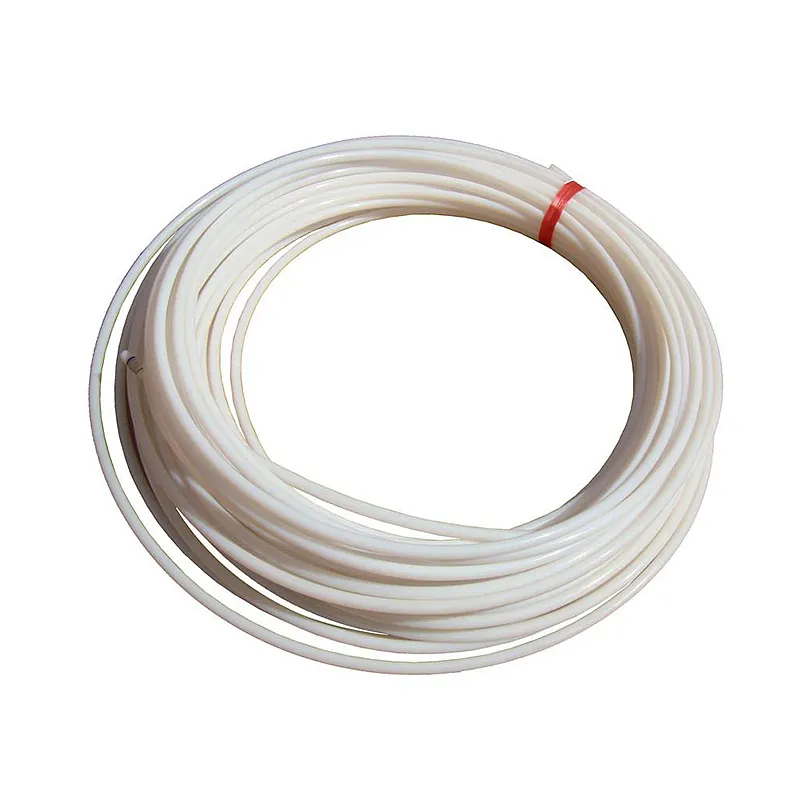PTFE Tubing: Comprehensive Guide
enero 28, 2025
What Is PTFE Tubing?
PTFE (Polytetrafluoroethylene) tubing, also known as Teflon tubing, is a type of plastic tubing made from polytetrafluoroethylene resin. It is renowned for its exceptional properties such as high temperature resistance, chemical inertness, non-stick surface, and low friction coefficient.
Benefits of PTFE Tubing
1.Resistencia a la temperatura: Tubo de PTFE can withstand temperatures ranging from -100°C to +260°C, making it suitable for extreme environments.
2.Chemical Compatibility: It is highly resistant to most chemicals and solutions, except for sodium, potassium, and lithium, which can affect its chemical stability.
3.Non-stick Surface: The low surface tension of PTFE prevents adhesion of any material, facilitating fluid flow and eliminating media buildup.
4.Low Friction: With the lowest friction coefficient among polymers, PTFE tubing is ideal for applications requiring lubrication.
5.Biocompatibility: It is safe for use in medical applications due to its non-toxic and non-reactive properties.

Types of PTFE Tubing
1. Standard Wall Tubing: Suitable for general-purpose applications.
2. Heavy Wall Tubing: Offers additional mechanical strength and pressure resistance.
3. Thin Wall Tubing: Used in applications where space is limited.
4. Film-Cast Tubing: Ideal for thin-walled liners requiring high flexibility.
5 .Ram-Extruded Tubing: Preferred for larger-bore delivery systems or devices needing high tensile strength.
6 . AWG (American Wire Gauge) & Fractional Tubing: Designed for electrical insulation applications, with varying wall thicknesses.
Application of PTFE Tubing
1.Fluid Handling: Used in systems handling chemicals, corrosive materials, and other fluids.
2. Medical Devices: Ideal for catheters, introducer sheaths, and other medical applications due to its biocompatibility and low friction.
3. Aislamiento eléctrico: Suitable for wire and cable insulation, circuit boards, and other electrical components.
4.Semiconductor Industry: Utilized in processes requiring high purity and chemical resistance.
5. Food and Beverage: Safe for use in food processing and handling due to its non-toxic properties.
Process of PTFE Tubing Manufacturing
1. Raw Material Preparation: High-quality PTFE resin is selected and processed into a form suitable for extrusion.
2 . Extrusion: The resin is heated to a semi-liquid state and forced through a die to create the desired tubing shape and size.
3. Cooling and Sintering: The tubing is rapidly cooled and then sintered in an oven to enhance its mechanical properties.
4 . Quality Control and Inspection: Rigorous testing ensures the tubing meets specified dimensions and properties.
5. Secondary Operations: May include cutting to length, flaring, or adding fittings as per the final application requirements.
How to Maintain PTFE Tubing
1. Regular Cleaning: Use clean water or mild detergents to clean the tubing surface. Avoid using abrasive tools or chemicals that could damage the tubing.
2. Inspection: Regularly inspect the tubing for any signs of wear, deformation, or damage. Replace damaged tubing promptly.
3. Control Media Quality: Ensure the media flowing through the tubing is free of excessive impurities to prevent clogging.
4 . Storage: Store PTFE tubing in a dry, ventilated, and light-protected environment when not in use.
Chemical Reasoning for PTFE Properties
PTFE’s unique properties stem from its chemical structure. The strong carbon-fluorine bonds make it highly resistant to chemical attack, while the absence of intermolecular hydrogen bonding contributes to its low friction and non-stick properties.
Differences Between PTFE and PFA
Both PTFE and PFA (Perfluoroalkoxy) are fluoropolymers with similar properties, but with some key differences:
1. Temperature Resistance: PTFE has a higher temperature resistance than PFA.
2. Melt Processability: PFA can be melt-processed, making it easier to fabricate into complex shapes, whereas PTFE is processed through sintering.
3. Transparency: PFA is transparent, while PTFE is usually opaque.
How to Choose PTFE Tubing
When selecting Tubo de PTFE, consider factors such as:
1. Application Requirements: Choose tubing based on the specific needs of your application, such as temperature range, chemical compatibility, and pressure rating.
2. Espesor de pared: Select the appropriate wall thickness for your application, balancing mechanical strength and flexibility.
3. Length and Customization: Determine the required length and whether customization, such as color or striped tubing for identification, is needed.
4. Supplier Reputation: Choose a reputable supplier known for quality and reliability.
PTFE Tube FAQ
Q: Is PTFE tubing safe for food and beverage applications?
A: Yes, Tubo de PTFE is non-toxic and inert, making it safe for use in food and beverage processing.
Q: Can PTFE tubing withstand high temperatures?
A: Yes, PTFE tubing can withstand temperatures up to 260°C, making it suitable for extreme environments.
Q: How is PTFE tubing manufactured?
A: PTFE tubing is manufactured through a process involving raw material preparation, extrusion, cooling, sintering, and quality control.
In conclusion, PTFE tubing offers a wide range of benefits and is suitable for numerous applications. Understanding its properties, types, and maintenance requirements will help you make informed decisions when selecting and using PTFE tubing.
 +86-13752771911
+86-13752771911 E-mail:ptfetube@yozonetech.cn
E-mail:ptfetube@yozonetech.cn


